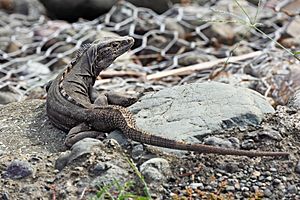Oaxacan spinytail iguana facts for kids
Quick facts for kids Oaxacan spinytail iguana |
|
|---|---|
 |
|
| Conservation status | |
| Scientific classification | |
| Genus: |
Ctenosaura
|
| Species: |
quinquecarinata
|
| Synonyms | |
The Oaxacan spinytail iguana (scientific name: Ctenosaura quinquecarinata) is a fascinating type of lizard. It is also known as the five-keeled spiny-tailed iguana. This reptile belongs to the Iguanidae family, which includes many well-known iguanas. It is native to Central America.
Contents
Where Does This Iguana Live?
You can find the Oaxacan spinytail iguana in countries like Costa Rica and Nicaragua. Some reports also suggest it lives in Mexico and El Salvador. It prefers warm, tropical areas.
Its Natural Home
This iguana's natural habitat is in tropical dry forests. These are forests that experience both wet and dry seasons. It needs these specific environments to survive and thrive.
What Does It Look Like?
The Oaxacan spinytail iguana has a very unique tail. Its tail is covered with five rings of spines. These spines form special ridges along its tail.
Size and Color
Male iguanas of this species can grow up to about 35 centimeters (14 in) long. Females are a bit smaller, reaching about 18.5 centimeters (7.3 in). Like many Ctenosaura iguanas, they are born a bright green color. As they get older, their color changes to brown. Females usually turn a plain brown. Males develop cool black, blue, and yellow colors on their bodies and heads, over a brown background.
Why Is It in Danger?
The Oaxacan spinytail iguana is facing some serious threats. Scientists do not know the exact number of these iguanas left. However, they estimate there might be fewer than 2,500 adult iguanas.
Threats to Its Survival
One major threat is habitat loss. This happens when the forests where they live are cut down. This is often due to deforestation. Another problem is that people sometimes collect these iguanas. They are taken from the wild to be sold as pets. This collection is often not controlled. Sadly, some people also hunt these iguanas for food. All these activities make it harder for the Oaxacan spinytail iguana to survive in the wild.
How Did It Get Its Name?
The Oaxacan spinytail iguana was first described by a zoologist named John Edward Gray in 1842. He first called it Cyclura quinquecarinata. Later, in 1874, another scientist named Marie Firmin Bocourt changed its name to Ctenosaura quinquecarinata.
Meaning of Its Scientific Name
The first part of its scientific name, Ctenosaura, comes from two Greek words. Ctenos means "comb," and saura means "lizard." This refers to the comb-like spines on the iguana's back and tail. The second part, quinquecarinata, comes from two Latin words. Quinque means "five," and carinata means "keeled." This part of the name describes the five rows of scales on the iguana's tail.
See also
 In Spanish: Garrobo enano de cola de garrote para niños
In Spanish: Garrobo enano de cola de garrote para niños


